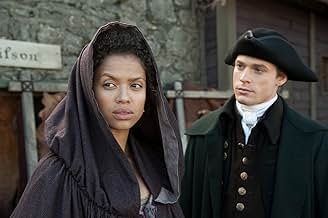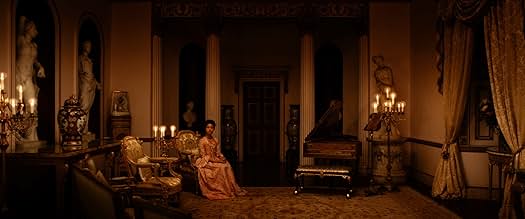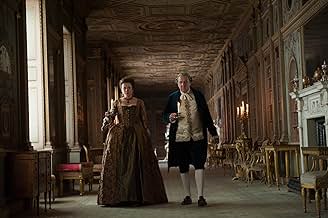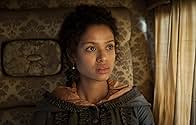Sigue la historia de Dido Elizabeth Belle, quien es criada por el aristocrático tío abuelo Lord William Murray, primer conde de Mansfield en la Inglaterra del siglo XVIII. .Sigue la historia de Dido Elizabeth Belle, quien es criada por el aristocrático tío abuelo Lord William Murray, primer conde de Mansfield en la Inglaterra del siglo XVIII. .Sigue la historia de Dido Elizabeth Belle, quien es criada por el aristocrático tío abuelo Lord William Murray, primer conde de Mansfield en la Inglaterra del siglo XVIII. .
- Dirección
- Guionista
- Elenco
- Premios
- 13 premios ganados y 32 nominaciones en total
- Dirección
- Guionista
- Todo el elenco y el equipo
- Producción, taquilla y más en IMDbPro
Opiniones destacadas
Although "Belle" tells a highly fictionalised account of her life, Dido Elizabeth Belle Lindsay was a real person. She was the illegitimate daughter of a British naval officer and a black slave. Unlike many children born in similar circumstances, however, she was fortunate in that her father acknowledged her and paid for her keep. When her mother died, her father brought her from the West Indies to England and entrusted her to the care of uncle, Lord Mansfield, who just happened to be the Lord Chief Justice. When her father died she inherited his fortune, making her a desirable heiress.
This is essentially a Jane Austen story, set a generation earlier and with a racial element thrown in. The film centres on Dido's emotional relationships. She is sought in marriage by Oliver Ashford, the younger son of an aristocratic family, but his interest is largely financial and the match is fiercely opposed by his mother and his elder brother, both of whom object to the idea of a mixed-race woman marrying into their family. The great love of her life is John Davinier, a clergyman's son, an aspiring lawyer and an ardent anti-slavery campaigner.
At her uncle's stately home Kenwood House, Dido is placed in a strange and anomalous position. By reason of her fortune she is an insider, part of England's establishment; Mansfield even worries that, because of the disparity in their financial positions she might be "marrying beneath herself" if she accepts John. Her race and her illegitimacy, however, make her an outsider. She is allowed to dine with the family when they are alone, but is forced to eat separately when they have guests who might be upset by the sight of a black face. Her position contrasts strangely with that of her cousin and close friend Lady Elizabeth Murray, another niece and ward of Lord Mansfield. Elizabeth is legitimate, but has no fortune of her own, having been virtually disowned by her father under the influence of his second wife. Yet because she is white there can be no question of Elizabeth having to dine apart from the family.
Set against the love of Dido and John is a subplot about what became known as the "Zong case". When sickness broke out on a slave ship, the captain ordered the crew to throw the slaves overboard. When the insurance company refused to compensate the ship-owners for their losses, the owners sued. Lord Mansfield was the judge who heard the case in the Court of King's Bench.
Tom Wilkinson has given a number of fine performances in recent British films (and sometimes in Hollywood too), and this is one of his best. In his dealings with Dido, whom he loves dearly, Mansfield is torn between his inner decency and the need to conform to the social proprieties of the period. In legal matters he is equally torn between the demands of the law and those of justice, which is not always the same thing. In the "Zong" case he is well aware that, in refusing to pay out on the policy the insurers are motivated by commercial considerations, not humanitarian ones; if they had any humanitarian feelings they would not have become involved in facilitating the slave trade in the first place. Nevertheless, he is equally well aware that a decision against the ship- owners will be seen as a victory for the growing anti-slavery movement and a step on the road to the abolition of the slave trade. Other good performances come from newcomer Gugu Mbatha-Raw in the leading role, Penelope Wilton as Lord Mansfield's sister and Sam Reid as John.
The film has something in common with "Amazing Grace", another film about the abolitionist movement; both tend to suggest that the fight against slavery was something waged by upper-class people in wigs sitting in elegant Georgian drawing-rooms, although "Belle" does at least put a black character at centre stage. Dido, moreover, would have known about the horrors of slavery through personal experience, whereas the likes of John Davinier and Lord Mansfield only know about them at second hand. For this reason I would have liked to see more about Dido's childhood in the West Indies before the death of her mother.
As one might expect of a British costume drama, "Belle" is visually attractive, but it is more than a mere pretty face. The "heritage cinema" genre is sometimes dismissed as a mere exercise in sentimental nostalgia, but it can be much more than that. It can also be (as in much of the work of Merchant-Ivory) a vehicle for exploring significant issues, and in this case manages to explore the questions of race, social class, compassion, justice and freedom. As Lord Mansfield put it, "Fiat justitia, ruat caelum". Let justice be done though the heavens fall. 8/10
This is essentially a Jane Austen story, set a generation earlier and with a racial element thrown in. The film centres on Dido's emotional relationships. She is sought in marriage by Oliver Ashford, the younger son of an aristocratic family, but his interest is largely financial and the match is fiercely opposed by his mother and his elder brother, both of whom object to the idea of a mixed-race woman marrying into their family. The great love of her life is John Davinier, a clergyman's son, an aspiring lawyer and an ardent anti-slavery campaigner.
At her uncle's stately home Kenwood House, Dido is placed in a strange and anomalous position. By reason of her fortune she is an insider, part of England's establishment; Mansfield even worries that, because of the disparity in their financial positions she might be "marrying beneath herself" if she accepts John. Her race and her illegitimacy, however, make her an outsider. She is allowed to dine with the family when they are alone, but is forced to eat separately when they have guests who might be upset by the sight of a black face. Her position contrasts strangely with that of her cousin and close friend Lady Elizabeth Murray, another niece and ward of Lord Mansfield. Elizabeth is legitimate, but has no fortune of her own, having been virtually disowned by her father under the influence of his second wife. Yet because she is white there can be no question of Elizabeth having to dine apart from the family.
Set against the love of Dido and John is a subplot about what became known as the "Zong case". When sickness broke out on a slave ship, the captain ordered the crew to throw the slaves overboard. When the insurance company refused to compensate the ship-owners for their losses, the owners sued. Lord Mansfield was the judge who heard the case in the Court of King's Bench.
Tom Wilkinson has given a number of fine performances in recent British films (and sometimes in Hollywood too), and this is one of his best. In his dealings with Dido, whom he loves dearly, Mansfield is torn between his inner decency and the need to conform to the social proprieties of the period. In legal matters he is equally torn between the demands of the law and those of justice, which is not always the same thing. In the "Zong" case he is well aware that, in refusing to pay out on the policy the insurers are motivated by commercial considerations, not humanitarian ones; if they had any humanitarian feelings they would not have become involved in facilitating the slave trade in the first place. Nevertheless, he is equally well aware that a decision against the ship- owners will be seen as a victory for the growing anti-slavery movement and a step on the road to the abolition of the slave trade. Other good performances come from newcomer Gugu Mbatha-Raw in the leading role, Penelope Wilton as Lord Mansfield's sister and Sam Reid as John.
The film has something in common with "Amazing Grace", another film about the abolitionist movement; both tend to suggest that the fight against slavery was something waged by upper-class people in wigs sitting in elegant Georgian drawing-rooms, although "Belle" does at least put a black character at centre stage. Dido, moreover, would have known about the horrors of slavery through personal experience, whereas the likes of John Davinier and Lord Mansfield only know about them at second hand. For this reason I would have liked to see more about Dido's childhood in the West Indies before the death of her mother.
As one might expect of a British costume drama, "Belle" is visually attractive, but it is more than a mere pretty face. The "heritage cinema" genre is sometimes dismissed as a mere exercise in sentimental nostalgia, but it can be much more than that. It can also be (as in much of the work of Merchant-Ivory) a vehicle for exploring significant issues, and in this case manages to explore the questions of race, social class, compassion, justice and freedom. As Lord Mansfield put it, "Fiat justitia, ruat caelum". Let justice be done though the heavens fall. 8/10
I wanted to see this movie because it is a period piece. I did not know that it is based on a true story . I loved the settings, the costumes, the writing and the acting. A well written story of the start of the road to abolishing slavery in England. The Story of DIdo - the caring aunt and uncle who took her under their roof, the other niece who they are raising also and how she develops into a beautiful and very smart lady. I'm sure the reactions by the people at that time were presented accurately. Dido was not allowed to eat with company but could with just the family. The courting of the women when they were of that age was interesting to watch and the conniving by the mother of the two -oh so different men in the name of wanting more money to come from the women. I especially like the intelligence of Dido and how it came out in the age of when women were not to be involved in politics or anything other than the home. A beautifully photographed film.
I saw this film at the San Francisco International Film Festival. I don't usually see two films in one day and was tired after already seeing another film, but Belle woke me up. I really enjoyed it.
This film would have been OK as a total fiction but given that it was based on a true story, I found it fascinating. Set in England in the late 1700's, it shows the impact of the slave trade on society. The patriarch of the family is a justice of the High Court of England and takes on an important case regarding a slave trading ship while confronting the reality of limitations faced by his mulatto niece. It shows that when someone becomes part of your family, and you love that person, it changes your perspective on cultural norms. This film has prompted me to look into the history of the actual legal case involved.
The film also showed the similarities between his white and mulatto nieces: as women both had a price on their heads and suffered due to their "place" in that society beneath men... This film showed that while much has changed, many attitudes have not changed in 300 years... The two brothers who court the nieces could have come from any current film if they just updated their styles of clothes, hair, and accents.
This film would have been OK as a total fiction but given that it was based on a true story, I found it fascinating. Set in England in the late 1700's, it shows the impact of the slave trade on society. The patriarch of the family is a justice of the High Court of England and takes on an important case regarding a slave trading ship while confronting the reality of limitations faced by his mulatto niece. It shows that when someone becomes part of your family, and you love that person, it changes your perspective on cultural norms. This film has prompted me to look into the history of the actual legal case involved.
The film also showed the similarities between his white and mulatto nieces: as women both had a price on their heads and suffered due to their "place" in that society beneath men... This film showed that while much has changed, many attitudes have not changed in 300 years... The two brothers who court the nieces could have come from any current film if they just updated their styles of clothes, hair, and accents.
- A love story and the value of being honest to yourself is what Belle is about. This movie transports you to the 1700s England. Based on the true story of Dido Elizabeth Belle "Belle", this tale is about a young mulato girl named Belle that is brought into her father's house and caretaker of her great-uncle Lord Mansfield a honorable Chief Judge and wife. Belle has all the rights and privileges of upper society but her face reflects her slave mother and the prevailing social prejudice keeps her from being totally accepted into the formal social circles. At the same time, she befriends her cousin, who she considers a sister and is also given residence to this estate after her mother dies and her father abandons her. This story is beautifully layered with the issues of equality and slavery but is not preachy. It merely shows how the matters of the heart can't be prevented by the color of your skin. This coming of age story is masterfully told. I saw this film as part of the Atlanta Film Festival.
I just saw an advance screening of BELLE--and I absolutely loved it. The dialog, directing, performances, costumes, locations, and cinematography were all fabulous.
It's based on the mesmerizing and romantic true story of the beautiful, intelligent, mixed race daughter of an admiral, who was raised in Georgian England by her aristocratic great-uncle and his wife. The script hits all the right notes as Belle struggles to find her place in a society that doesn't quite accept her, and with the help of an idealistic young vicar's son (Sam Reid-- fantastic), influences an important anti-slavery case.
Congratulations to director Amma Asante and writer Misan Sagay for bringing this story vividly to life on the screen. Gugu Mbatha-Raw was luminous as Dido Belle, and I think Tom Wilkinson gave the best role of his career. Both are Oscar-worthy performances. The film is highly recommended.
It's based on the mesmerizing and romantic true story of the beautiful, intelligent, mixed race daughter of an admiral, who was raised in Georgian England by her aristocratic great-uncle and his wife. The script hits all the right notes as Belle struggles to find her place in a society that doesn't quite accept her, and with the help of an idealistic young vicar's son (Sam Reid-- fantastic), influences an important anti-slavery case.
Congratulations to director Amma Asante and writer Misan Sagay for bringing this story vividly to life on the screen. Gugu Mbatha-Raw was luminous as Dido Belle, and I think Tom Wilkinson gave the best role of his career. Both are Oscar-worthy performances. The film is highly recommended.
¿Sabías que…?
- TriviaIn real life, Lady Elizabeth Murray married first to George Finch-Hatton, 10th Earl of Winchilsea. Their great-grandson was Denys Finch Hatton, who was played by Robert Redford in África mía (1985).
- ErroresEngagement rings were not used in the late 1700s. They didn't emerge until the 1920s.
- Citas
Dido Elizabeth Belle: My greatest misfortune would be to marry into a family who would carry me as their shame.
- ConexionesFeatured in Belle: The Story (2014)
- Bandas sonorasPiano Suite in G Minor, HWV 439, Allemande
Composed by George Frideric Handel
Selecciones populares
Inicia sesión para calificar y agrega a la lista de videos para obtener recomendaciones personalizadas
- How long is Belle?Con tecnología de Alexa
Detalles
- Fecha de lanzamiento
- País de origen
- Sitios oficiales
- Idiomas
- También se conoce como
- Белль
- Locaciones de filmación
- Productoras
- Ver más créditos de la compañía en IMDbPro
Taquilla
- Presupuesto
- USD 10,900,000 (estimado)
- Total en EE. UU. y Canadá
- USD 10,726,630
- Fin de semana de estreno en EE. UU. y Canadá
- USD 106,578
- 4 may 2014
- Total a nivel mundial
- USD 16,607,575
- Tiempo de ejecución1 hora 40 minutos
- Color
- Mezcla de sonido
- Relación de aspecto
- 2.35 : 1
Contribuir a esta página
Sugiere una edición o agrega el contenido que falta





































